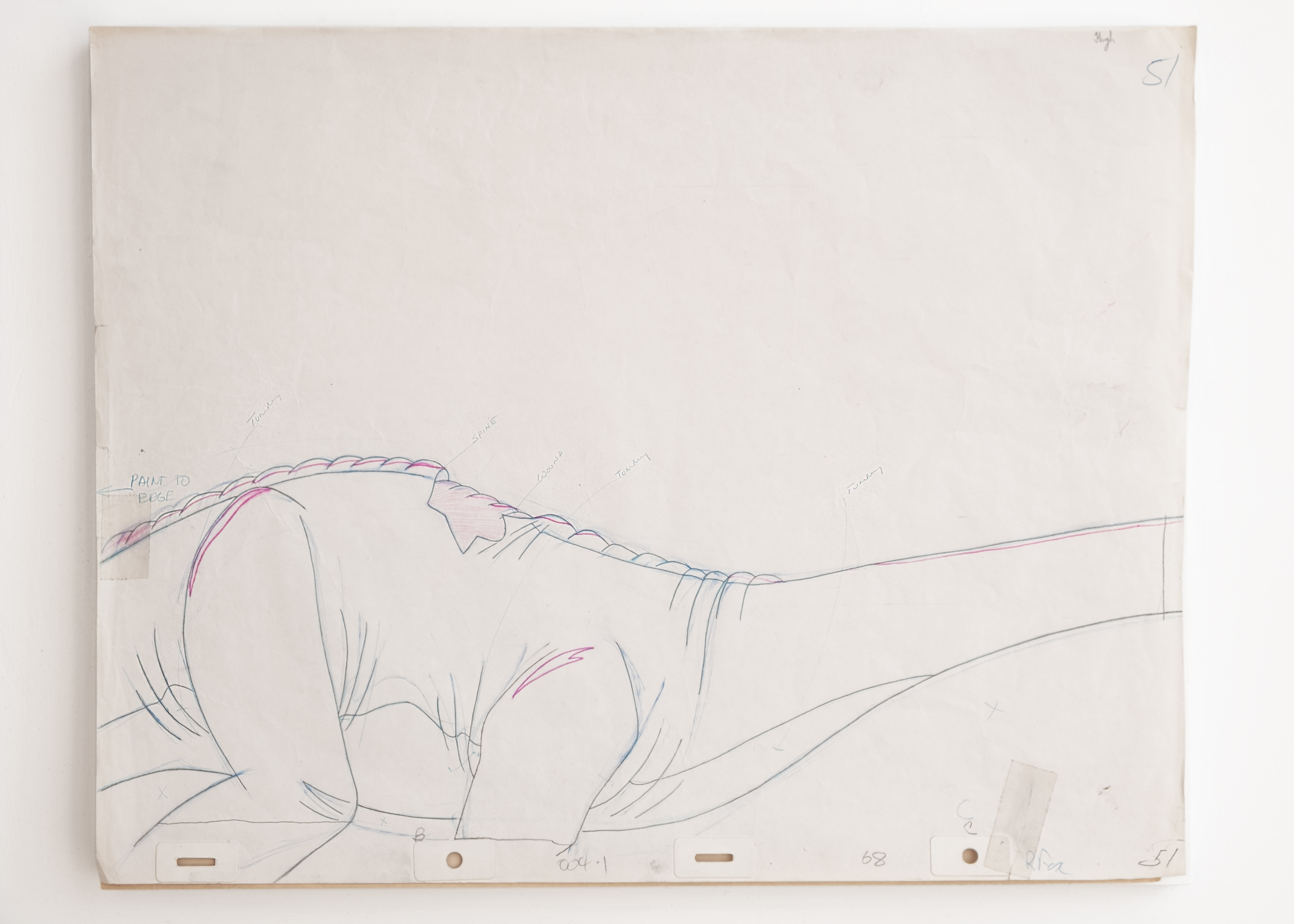Sudden arrest between two movements
Jacob Blackaller
Don Bluth
Lee Lozano
Marietta Mavrokordatou
Rechonski
29 Ability Plaza, Arbutus Street
London, United Kingdom
2 May - 8 June, 2025
Sudden arrest between two movements is a phrase used by Giorgio Agamben to describe the choreographic term, phantasm: a charged instance between movements which contracts the measure and the memory of the entire choreographic series.1
“ORDINARILY we are convinced otherwise. Aren't there moments of pure seeing, when I'm not trying to find anything in particular? Even if desire infects seeing, can't there be times when I am in remission from the incessant urging of desire? Is looking always also shopping and hunting and loving and dreaming, never blank, affectless seeing? As I write these lines, I'm sitting at a desk that faces a blank wall. I like it that way because it offers no distraction, but sometimes I turn my head to my left, where there's a panorama of the city. Today is a particularly beautiful summer afternoon with a bright hazy sky. The trees are sheets of green broken by buildings, and there's a lake scattered with white sails. My eyes love this scene, and I keep looking away from the computer and letting my gaze drift through the trees and the heavy air and then out onto the distant lake. Could there be anything tense about this? Is this still a kind of hunger? I think it may be, since I also look out there when I find myself at a loss for a word or an idea. Writing is hard, and when my concentration is broken it needs to be healed by bathing in the soft, meaningless landscape. That unselfish, abstracted, empty moment I spend looking at sailboats and thinking of nothing is really an oasis for my eyes, a source of nourishment that lets me continue my pursuit of words. It only seems to be a senseless pleasure. It's more like a quick drink of water during a speech or a gasp of air after a long dive. I would almost say that the moments I spend looking at the view are not looking at all: they are the gasps between looking, the balm that lets me use my eyes as pitilessly as I can. Seeing is incessant searching from the first moments we can focus our blurry infant eyes all the way to the closing second when we last see the world.” - James Elkins2
1. Agamben, Giorgio. 1993. Stanzas: Word and Phantasm in Western Culture. University of Minnesota Press.
2. Elkins, James. 1996. The Object Stares Back: On the Nature of Seeing. Harcourt Brace.
Jacob Blackaller
Don Bluth
Lee Lozano
Marietta Mavrokordatou
Rechonski
29 Ability Plaza, Arbutus Street
London, United Kingdom
2 May - 8 June, 2025
Sudden arrest between two movements is a phrase used by Giorgio Agamben to describe the choreographic term, phantasm: a charged instance between movements which contracts the measure and the memory of the entire choreographic series.1
“ORDINARILY we are convinced otherwise. Aren't there moments of pure seeing, when I'm not trying to find anything in particular? Even if desire infects seeing, can't there be times when I am in remission from the incessant urging of desire? Is looking always also shopping and hunting and loving and dreaming, never blank, affectless seeing? As I write these lines, I'm sitting at a desk that faces a blank wall. I like it that way because it offers no distraction, but sometimes I turn my head to my left, where there's a panorama of the city. Today is a particularly beautiful summer afternoon with a bright hazy sky. The trees are sheets of green broken by buildings, and there's a lake scattered with white sails. My eyes love this scene, and I keep looking away from the computer and letting my gaze drift through the trees and the heavy air and then out onto the distant lake. Could there be anything tense about this? Is this still a kind of hunger? I think it may be, since I also look out there when I find myself at a loss for a word or an idea. Writing is hard, and when my concentration is broken it needs to be healed by bathing in the soft, meaningless landscape. That unselfish, abstracted, empty moment I spend looking at sailboats and thinking of nothing is really an oasis for my eyes, a source of nourishment that lets me continue my pursuit of words. It only seems to be a senseless pleasure. It's more like a quick drink of water during a speech or a gasp of air after a long dive. I would almost say that the moments I spend looking at the view are not looking at all: they are the gasps between looking, the balm that lets me use my eyes as pitilessly as I can. Seeing is incessant searching from the first moments we can focus our blurry infant eyes all the way to the closing second when we last see the world.” - James Elkins2
1. Agamben, Giorgio. 1993. Stanzas: Word and Phantasm in Western Culture. University of Minnesota Press.
2. Elkins, James. 1996. The Object Stares Back: On the Nature of Seeing. Harcourt Brace.


Jacob Blackaller
Moment realised at six points, 2025
Steel
dimensions vary






Rechonski
Witness, 2025
Inkjet print in perspex frame, binoculars, newspaper
dimensions vary




Lee Lozano
No title, c. 1964
Coloured pencil, graphite, and ink on grid paper, frame
8 x 19.5 cm (unframed); 25 x 36.5 x 3 (framed)


Don Bluth
No title, c. 1987
Coloured pencil, graphite, ink, and tape on paper, artist frame
34 x 43.5 cm (unframed); 50 x 70 x 4 cm (framed)



Marietta Mavrokordatou
Bedside table blues, 2025
Archival pigment print, dibond
60 x 80 cm